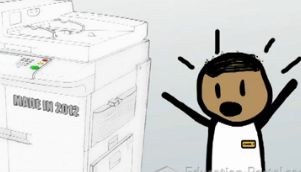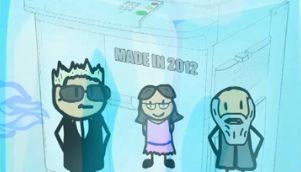Lewin's 3-Stage Model of Change: Unfreezing, Changing & Refreezing
After you watch the video and know the material, click HERE for the quiz.
Organizational change does not have to be a complex process. In fact, Kurt Lewin did it in just three steps. This lesson discusses the three stages of organizational change according to Lewin, including unfreezing, changing and refreezing.
Kurt Lewin's Change Model
Kurt Lewin developed a change model involving three steps: unfreezing, changing and refreezing. The model represents a very simple and practical model for understanding the change process. For Lewin, the process of change entails creating the perception that a change is needed, then moving toward the new, desired level of behavior and finally, solidifying that new behavior as the norm. The model is still widely used and serves as the basis for many modern change models.
Unfreezing
Before you can cook a meal that has been frozen, you need to defrost or thaw it out. The same can be said of change. Before a change can be implemented, it must go through the initial step of unfreezing. Because many people will naturally resist change, the goal during the unfreezing stage is to create an awareness of how the status quo, or current level of acceptability, is hindering the organization in some way. Old behaviors, ways of thinking, processes, people and organizational structures must all be carefully examined to show employees how necessary a change is for the organization to create or maintain a competitive advantage in the marketplace. Communication is especially important during the unfreezing stage so that employees can become informed about the imminent change, the logic behind it and how it will benefit each employee. The idea is that the more we know about a change and the more we feel it is necessary and urgent, the more motivated we are to accept the change.
 |
Changing
Now that the people are 'unfrozen' they can begin to move. Lewin recognized that change is a process where the organization must transition or move into this new state of being. This changing step, also referred to as 'transitioning' or 'moving,' is marked by the implementation of the change. This is when the change becomes real. It's also, consequently, the time that most people struggle with the new reality. It is a time marked with uncertainty and fear, making it the hardest step to overcome. During the changing step people begin to learn the new behaviors, processes and ways of thinking. The more prepared they are for this step, the easier it is to complete. For this reason, education, communication, support and time are critical for employees as they become familiar with the change. Again, change is a process that must be carefully planned and executed. Throughout this process, employees should be reminded of the reasons for the change and how it will benefit them once fully implemented.
 |
Refreezing
Lewin called the final stage of his change model freezing, but many refer to it as refreezing to symbolize the act of reinforcing, stabilizing and solidifying the new state after the change. The changes made to organizational processes, goals, structure, offerings or people are accepted and refrozen as the new norm or status quo. Lewin found the refreezing step to be especially important to ensure that people do not revert back to their old ways of thinking or doing prior to the implementation of the change. Efforts must be made to guarantee the change is not lost; rather it needs to be cemented into the organization's culture and maintained as the acceptable way of thinking or doing. Positive rewards and acknowledgment of individualized efforts are often used to reinforce the new state because it is believed that positively reinforced behavior will likely be repeated.
 |
Some argue that the refreezing step is outdated in contemporary business due to the continuous need for change. They find it unnecessary to spend time freezing a new state when chances are it will need to be reevaluated and possibly changed again in the immediate future. However - as I previously mentioned - without the refreezing step, there is a high chance that people will revert back to the old way of doing things. Taking one step forward and two steps back can be a common theme when organizations overlook the refreezing step in anticipation of future change.
Apply Lewin's Three Steps
To better understand Lewin's change model, let's take a look at the following example.
Kiddie Chiropractic has decided to switch from using hand-written medical records to electronic ones. All of the staff at Kiddie have always relied on hand-written medical records when performing their jobs and have expressed concerns about switching to the new electronic format. However, Kiddie management believes that making the switch to electronic records will increase efficiency and reduce the amount of time that it takes to record patient information.
First, Kiddie management will have to spend time unfreezing the employees' belief that the old way of recording patient records is adequate. The management team will need to communicate the perceived benefits of the new electronic method, making sure to demonstrate how the pros outweigh the cons. The staff will need to understand how much more efficient the new method of electronic recording will be in comparison to the old hand-written process.
Next, Kidde management will need to transition into the changing stage by implementing the new electronic recording system. This will mark a time of uncertainly in the Kiddie staff, making it necessary for the management team to offer training and support as the employees become familiar with the new electronic system.
 |
Finally, Kiddie management will need to refreeze the new method of recording into the organization's culture, making certain that the staff recognizes the electronic system as the new norm and the manner in which they will record patient information going forward. The management team should also recognize the efforts made by the staff members to learn and use the new system by offering them some sort of reward and praise.
Lesson Summary
Let's review. Kurt Lewin developed a change model involving three steps: unfreezing, changing and refreezing. For Lewin, the process of change entails creating the perception that a change is needed, then moving toward the new, desired level of behavior and, finally, solidifying that new behavior as the norm.
The goal during the unfreezing stage is to create an awareness of how the status quo, or current level of acceptability, is hindering the organization in some way. The idea is that the more we know about a change and the more we feel that it is necessary and urgent, the more motivated we are to accept the change.
Once people are unfrozen they can begin to move into the implementation phase, also called the changing stage. During the changing stage, people begin to learn the new behaviors, processes and ways of thinking. The more prepared they are for this step, the easier it is to complete.
Lewin called the final stage of his change model freezing, but many refer to it as refreezing to symbolize the act of reinforcing, stabilizing and solidifying the new state after the change. The changes made to organizational processes, goals, structures, offerings or people are accepted and refrozen as the new norm or status quo.